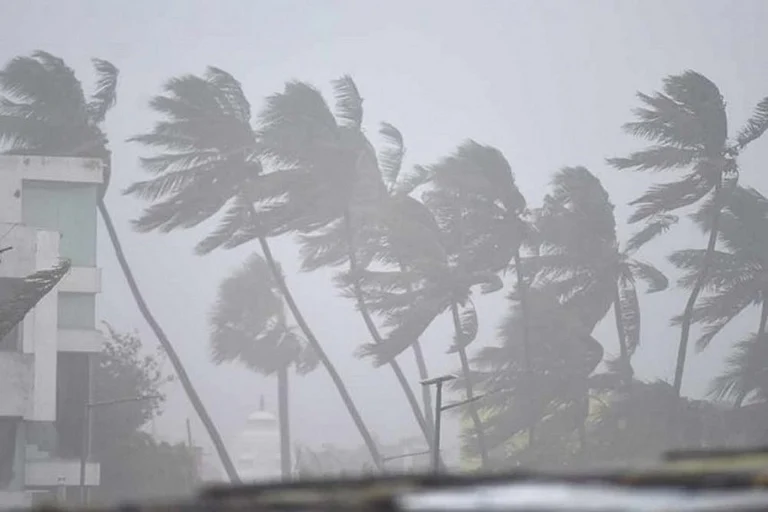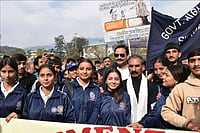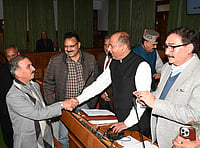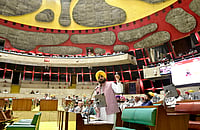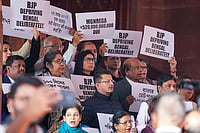
Disaster-Affected Communities Raise Concerns at People’s Public Hearing in Mandi
The Deputy Commissioner says full transparency is maintained, and relief is disbursed to all.
Reckless Hill Cutting and Tourism Pressure Behind Alarming Environmental Devastation
More than four months after Seraj—one of the state’s most remote mountain valleys—was ravaged by unprecedented cloudbursts and flash floods that uprooted families and swept away vast stretches of cultivable land, the suffering of the disaster-affected families continues as they struggle for shelter, livelihood, and basic relief.
With winters having already set in in Himachal Pradesh, the families are living in makeshift tents and under the tarpaulin shelters—the rehabilitation measures proving woefully insufficient and slow.
These are just bare facts, which came to light during the two-day-long People’s Public Hearing, held at Mandi on Saturday. Nearly 70 disaster-affected families of Mandi, Kullu, Kinnaur, and Lahaul-Spiti reached the town’s Saksharta Bhawan to narrate their woes before a seven-member civil society panel.
Damaged homes, devastated lands, wiped-out livelihoods, snapped road connectivity, unsafe settlements, and loss of close family members are a few of the affected families ' heart-wrenching individual stories narrated to the panel.
Meet Kesari Devi of Mughan village (Thunag), one of the many women from calamity-hit Seraj who have raised serious questions over the transparency of the damage-assessment survey. She, along with five other affected women, alleged that many genuinely deserving families were left out, while some names were arbitrarily included in the list for cash relief and other benefits.
According to them, several families who lost homes were told they were ineligible for rental relief unless they first moved into government relief camps—an unreasonable demand for many who had already found temporary accommodation with relatives or on rent. They shared deeply personal testimonies of losses.
“Yet almost every testimony pointed to something more troubling—that relief, rehabilitation, and reconstruction remain painfully slow, opaque, and inconsistent, even as disasters intensify year after year,” claimed members of the civil society groups, who had organised the hearing.
One of the foremost concerns raised throughout the hearing was the pending compensation for farmland loss and damaged houses, especially in the most severely affected pockets of the state.
The calamity-hit families pointed out that while immediate relief payments of Rs 1.30 lakh were distributed to many in the aftermath, this was uneven and has not been followed by timely assessments or the release of comprehensive compensation under the Special Relief Package (SRP). Numerous participants said they remain in limbo, uncertain whether they are even on the official lists.
When contacted, Deputy Commissioner Mandi Aproov Devgan said the government has so far disbursed over Rs 33 crore as compensation for damaged houses and other losses. In addition, Rs 18.50 crore has been provided to address the problems of affected families, all of whom were identified and duly verified by three separate teams of revenue officials.
“It is wrong to say that there was no transparency in relief distributions,” he added, and recalled that he himself went to the venue of the public hearing and explained everything to the families invited by the group of NGOs for the hearing.
A major issue that cut across testimonies was landlessness and the absence of clear rehabilitation pathways. Participants from Jogindernagar, Bungrail Chowk (Seraj), and Lindur village (Lahaul-Spiti) stressed that when houses are declared unsafe or swept away, people are prohibited from rebuilding—yet no land is provided for relocation.
Much of the suitable land falls under the Forest Department’s jurisdiction, requiring central government clearance, which can take years. Participants urged the central government to take swift action, emphasising that displacement without rehabilitation is abandonment.
However, the Deputy Commissioner clarifies that the majority of the affected individuals have received appropriate compensation and care. The only issue now remaining is making provisions for land as demanded by the families. But there is no policy to allot government lands. There is no non-forest land in the district.
“The Hon’ble Chief Minister and the state government have already taken up the matter with the Centre, seeking relaxation of the Forest Act to facilitate the rehabilitation of families who have become landless and houseless,” Devgan said.
Yet, during the proceedings, the participants alleged that families with ancestral homes in far-off villages were struck off the list despite losing the houses they currently lived in. Similarly, nuclear families who had separated from joint households were not being recognised as independent units.
As such, the burden of this exclusion falls disproportionately on single women, many of whom had built small independent structures near their parental homes that were washed away in disasters but are still not considered eligible for Special Relief Package assistance.
Neetu Ram from Chowki Baladi (Kullu) shared the devastating impact of the Malana Dam burst, which destroyed his home and belongings. Despite the scale of destruction, he has not received any relief, illustrating how affected people often slip through administrative and political cracks even in high-profile disaster cases.
Speakers from Kinnaur, Mandi, and Kullu also highlighted the mounting ecological pressures caused by relentless road construction, unregulated hill cutting, and unchecked muck dumping. These practices, combined with large-scale dam development, are creating cascading risks in an already fragile terrain.
The disasters in Mandi town this year were repeatedly cited—many attributed the severity of destruction to road-widening, tree felling, and blocked nallahs, for which departmental oversight remains weak, they pointed out.
Rajneesh Sharma, advocate and local journalist, raised concerns about the impact on education. In several disaster-hit villages, secondary school students have to walk long distances on unsafe terrain, while primary school buildings in several villages remain non-functional months after the monsoon, leaving younger children out of school altogether.
From Kullu, Lal Chand Katoch spoke strongly against mindless tourism and recalled the long community-led legal struggle against the proposed Ski Village project, backed by a multinational corporation. He asked the people to remain vigilant and take collective responsibility to prevent destructive projects from entering ecologically sensitive Himalayan regions.
The hearing was primarily organised collectively by over a dozen civil society groups. They included Ekal Nari Shakti Sangathan, Land Acquisition Affected Forum, Himalaya Niti Abhiyan, Himalok Jagriti Manch, Himachal Gyan-Vigyan Samiti, Himdhara Environment Collective, Jibhi Valley Tourism Development Association, Loktantra, Democratic Nation-Building Campaign, Mandi Literacy Committee, People for Himalaya Campaign, Mountain Women’s Rights Forum, People’s Campaign for Socio-Economic Equality, Save Lahaul-Spiti, and the Tower Line Affected Forum.
Meanwhile, Naresh Chauhan, CM's Principal Media Advisor, said that despite the centre's poor response to the state government's demand for a Special Relief Package and resource crunch, Chief Minister Sukhwinder Singh Sukhu has already distributed Rs. 81.28 crore to 4,914 beneficiaries through Direct Benefit Transfer (DBT) during a function held at Paddal Ground, Mandi, on November 10. The relief manual has also been changed after 2023 disasters to provide higher compensation for land, houses, and cattle-head losses
"We know the families have suffered massive devastation, lost family members, and been rendered homeless or landless. Public infrastructure, too, has suffered massively. The state is battling hard to rebuild its infrastructure; at the same time, the affected families are also trying to begin their lives again and construct dwelling places," he maintains.








